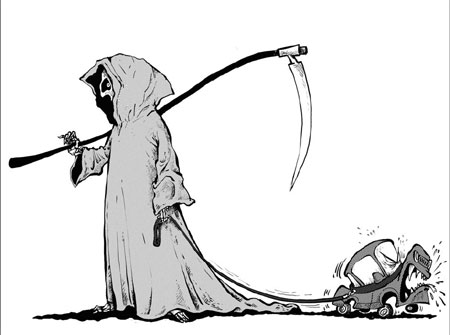Make road safety the new traffic mantra
Updated: 2011-11-03 08:11
By Deng Fei (China Daily)
|
|||||||||
|
Pang Li / China Daily |
China's roads are dangerous. The recent death of 2-year-old Yue Yue after being hit by two vehicles was followed just days later by the death of another child, this time a 5-year-old boy hit by a vehicle in Luzhou, Sichuan. On the National Day holiday a bus traveling in Hubei province fell 76 meters off a cliff killing 16 people. Days later, a speeding bus crashed causing the death of 35 people, mostly university students and, on that same day, a head-on collision with a truck in Henan province killed all 11 passengers in a van.
Road crashes are not just random accidents. They are indicative of a much larger problem. In lower income countries, the No 1 killer of people aged between 15 and 29 is road crashes. In China, road crashes rank only behind drowning as the leading killer of children between the age of 5 and 14.
Officially, 200 people die every day in China because of road crashes, about one death every seven minutes. Road crashes cost 1 percent to 3 percent of the country's GDP every year. At the same time, they devastate the lives of the injured and the relatives of the victims. China, with four times the population of the United States, has today only one-third the numbers of vehicles and yet it has twice as many deaths because of road crashes.
Two hundred lost lives is comparable to a fatal airplane crash every day. At these odds would we still fly or would airlines even be allowed to continue to fly? Highly unlikely. We would not fly and airlines would be forced to change. Yet every day millions of pedestrians, passengers and drivers are exposed to the same odds on the country's roads, and these odds seem to be much more acceptable. Why? Some believe it is an inevitable price of rapid social-economic progress. But this is a myth - road crashes are not meant to happen and are preventable.
Unprecedented economic growth in China has led to increased individual incomes which in turn have unleashed a rapid rate of motorization (almost everyone who can afford to, buys a car). This in turn sets loose on the roads an overwhelming number of new vehicles with new drivers behind the wheel.
Sometimes coupled with this newfound freedom of mobility is a mistaken sense of privilege (I own a car, I own the road). Though China has invested heavily in the physical construction of roads, it has paid less attention to ensuring that they are safe. China is not the first country to experience this, as fatality rates positively correlated with rapid economic growth is a common phenomenon. The difference is that developed countries have managed to reverse the trend by dramatically reducing road crashes even while car ownership continues to grow.
So what can be done in China?
Awareness, institutions, intervention, results. These are the pillars of lasting change.
Awareness begins with all of us: respect every traffic light, wear seatbelts, protect the children, do not drink and drive - the list is long but obvious. Give pedestrians the right of way; roads are built to serve all users and vehicles must yield to the vulnerable. Design roads and vehicles to accommodate road users' mistakes without causing injury and death.
Institutions provide an enabling environment through regulation, design, implementation and enforcement. Road safety involves a myriad of entities responsible for a diverse set of functions, including transport, health, public safety, education, law enforcement, vehicle design and emergency response. One way to address road safety is through the establishment of a national-level road safety agency tasked with comprehensive oversight, coordination, monitoring, and evaluation. Institutional structure should be coupled with a strong political will.
Short-term interventions could well begin by targeting priority issues. Enhanced education could focus on the low level of safety awareness among road users and insufficient training of new drivers. Greater enforcement could tackle users' compliance with traffic rules such as seatbelt use, speed limits, no drunk driving, safe design of vehicles and vehicle overloading. Better governance could crack down on corruption surrounding licensing and evasion of penalties. Adequate clearance between traffic, and pedestrians and businesses should be respected in design and construction of roads.
Countries such as the US and Canada have had success with the implementation of a graduated driver licensing system which begins with a learner's permit followed by a provisional license, and, if performance is acceptable, a full driver's license.
Decades ago, Australia sought enduring results by declaring war on road crashes. Through a concentrated and sustained effort at all levels of government, road crashes in Australia declined dramatically, so that today, the accident rate is at a historical low and holding steady.
As much as any country, China has been successful in establishing long term plans and persevering in the implementation of these plans. The time is now to do the same for road safety.
The author is a senior transport specialist at the World Bank headquarters in Washington, DC. She has collaborated with her government counterparts and implemented road safety projects in China and Vietnam.












